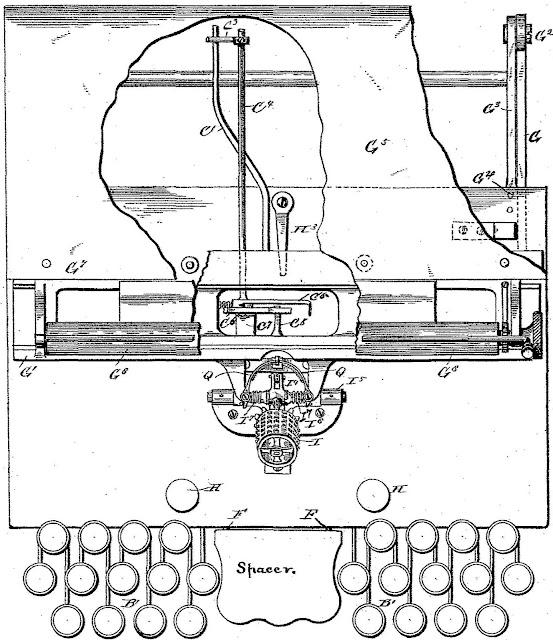PART 192
What have
we here? Well, believe it or not, they’re all typewriters, of a sort. Two are
from Charles Spiro and one each from Thomas Hall and Suyeoto Fujiki, all dating from 1880-1891. Spiro and Hall were, of course, among the true greats of typewriter inventing. But we know nothing of Fujiki, except that he appears to have been away ahead of his time.
First,
Hall’s famous index typewriter, one of the earliest typewriters ever marketed. A patent application was made on this
day (December 1) in 1880. It was issued
three months later.
Interestingly,
this same patent was at the centre of a Federal Circuit Court patent infringement case in
Massachusetts in July 1893, between the National Typewriter Company,
incorporated in Maine, and the Pope Manufacturing Company. It was decided the “defendant
[Pope], being a foreign corporation, incorporated under the laws of
Connecticut, cannot, under the recent decisions of the Supreme Court, be sued
in this district.” So did Pope make a version of the Hall? And why was this case heard in Massachusetts?
Hall machines were originally made by Hall's own company in New York and Salem, Massachusetts, but according to Paul Lippman's American Typewriters, National manufactured the "Boston Hall" in Philadelphia (from, I believe, 1889). According to the Smithsonian Institute, National is "not to be confused with the company in Philadelphia of the same name". But the Smithsonian seems to be utterly confused itself over whether the "New Model Hall" was made by National or the Philadelphia Typewriter Company. I'm afraid I can't sort that one out.
Here is
my Salem Hall, still without a plunger (but I’m getting to it …).
Thomas
Hall was born in Philadelphia on February 4, 1834, the son of an English-born
machinist, Henry Hall, and his wife Alice Baker Hall. Hall died in Brooklyn on
November 19, 1911, aged 77.
The Spiro
music writing typewriter was patented on this day in 1885. The machine sold for
$10 in 1886.
It was described in Appletons' Annual Cyclopaedia 1890 as the
Columbia typewriter having been adapted, “by a special device, to print in the
words of a song by the use of an additional typewheel. It is 4½ inches in
length, 2 inches in width, and 2½ inches in height, and weighs ½ a pound.
There is a disk, a handle, and a base. The disk contains on its periphery the
requisite characters ... The disks are three - one containing the notes, one
for inserting accidentals, and one for signatures and barring.”
Columbia 2
On this
day in 1891, Spiro was issued with a patent for this six-line typewheel (or more likely a typesleeve) typewriter.
I don’t know if anything became of the design.
Spiro was
born in Prussia on January 1, 1850. He later claimed (in passport applications and on census forms, no less) that he was born New York. He died in 1933.
Charles Spiro
Suyeoto
Fujiki, of Tokyo, was also issued with a “type writing machine” patent on this
day in 1891. Fujiki’s stopwatch-like typewriter looks suspiciously like the
famous Italian-made Taurus, described by Paul Robert at the Virtual Typewriter
Museum as "definitely one of the smallest, oddest, clumsiest and most
desirable typewriters ever produced". See.
The
Taurus was produced 17 years after Fujiki’s patent, in 1908, by Pietro Torrani
of Milan. The major difference between the two miniature typewriters is that
with Fujiki’s design, the device was laid on paper, whereas the Taurus had a
thin strip of paper inside the “watch”. Fujiki’s typewriter had an ink pad
rolling over the character ring, and a depression key on the opposite end to the
winder. The dial was essentially the same. Torrani and his associate Giovanni
Zanini, who made a “spy” camera, also called a Taurus, in 1904, perhaps adapted
Fujiki’s design when Fujiki’s patent expired in about 1905.















2 comments:
A very entertaining foursome, thanks.
The Spiro looks rather like a kiwi (bird) with a strange head. The fujiki is the grandfather of label makers I suppose.
Post a Comment